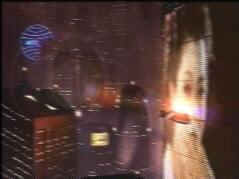Ubiquitous Advertising in the New Media Age

Remember Blade Runner (1982) with Harrison Ford? In the film's futuristic setting, advertising is very prominent. (The same was true with Minority Report in a way that I find anything but implausible.) The advrtising is very intrusive.
As the newspaper industry is faced with online challengers competing for many of the same advertising dollars (not to mention the classifieds), some shocking things are going on that sound a bit futuristic, if not science fiction. The Boston Globe just announced plans to sell advertisements on the covers of its Business, Sunday Real Estate, Sports, and Food sections, following the lead of such papers as The New York Times and, coming soon, The Wall Street Journal.
One of the themes of this blog is that the severity of changes in the new media age are truly historical (although we can return to old newspapers who had no qualms about front page ads and many were even given names like "The Advertiser." Why are newspapers resorting to these measures today? Well, let just say it seems they need an infusion of advertising dollars, and these pages will be prime real estate for advertisers. This also follows a parallel track in the cable and broadcast industry where advertising "bugs" appear on screen, during a show, and appear to be DVR-proof. Oh, uh, the international NO sign is from a group that is fighting "bugs" on television, an interesting backlash. As you may know, that lower corner of the screen is often where the network's logo appears.
What I continue to find fascinating is why these are limited to network logos and some animated promos for other TV shows on that network. I have yet to notice and advertiser's message going there. It's inevitable, and as soon as one major cable or bradcast network does it, the others will fall in line faster than elementary school kids lining up for recess.
You may use this content (better still, argue with me!), but please cite my ideas as © 2006, Dr. Bruce Klopfenstein. Find any typos! Don't smite me, let me know!
 Thanks blogger community for solving my mysterious error. I'll hang on to
Thanks blogger community for solving my mysterious error. I'll hang on to 

1 Comments:
In regards to the "bugs" that appear during television programs, I agree with you that eventually advertisers will use them as another form of advertising. I believe that the "bugs" have not already been used for this purpose because the networks do not want to press their luck so soon. There is only so much annoyance, or clutter, that I think viewers will take right now. Already, viewers are upset and critical about the amount of commercials that are aired. Also, with the advent of the DVR, viewers have eagerly embraced the practice of being able to fast forward through this unsavory content. But, I think there is a limit to what advertisers and the networks can get away with right now. By moving too fast into the world of "bugs" as advertising tools, networks risk alienating an audience and losing ratings.
As we have discussed in class, newspapers are starting to decline in prominence because of the competition they face from the other media outlets that consumers use for information. Based on this trend, I can understand why a newspaper, like the one you mention in your post, would be forced to sell ad space on the covers of sections in order to stay alive and to earn revenue. Advertising dollars have always been what keeps the media industry thriving, and I do not see this ever changing. But, television is not in the same position as newspapers are right now. Television is not losing consumers (or viewers) to the extent that newspapers are. This is another reason why I think "bugs" have not been sold to advertisers, because television has not needed to do this yet.
But, eventually, someone will be bold enough to give this practice a try as a means of earning even more revenue. If bug advertising is accepted by viewers, I worry about what other developments in advertising this may inspire. Right now, the "bugs" are relatively small and are contained in the corner of the screen. But, I speculate that if the "bugs" are accepted by viewers in their current form, then eventually the "bugs" would become even more intrusive. There would then be nothing to stop the networks from say, taking a "ticker" approach to ad content, and allow ads to be run at the bottom of the screen during an entire program. Also, "hot switching" (where the next program begins in a split screen while the credits from the ending program are running) could be another possibility for advertising. By this, I mean that the screen would be split, and that the program would run in the top half, while ads could run in the bottom half of the screen. If viewers are already annoyed by advertising in its current form, then I imagine they would be livid over advertising presented in the possibilities that I outlined above.
I understand that advertising is important to broadcasting, but I think there is a limit to what viewers will tolerate.
Post by: Brandi Kilgore--TELE 4450
Post a Comment
<< Home